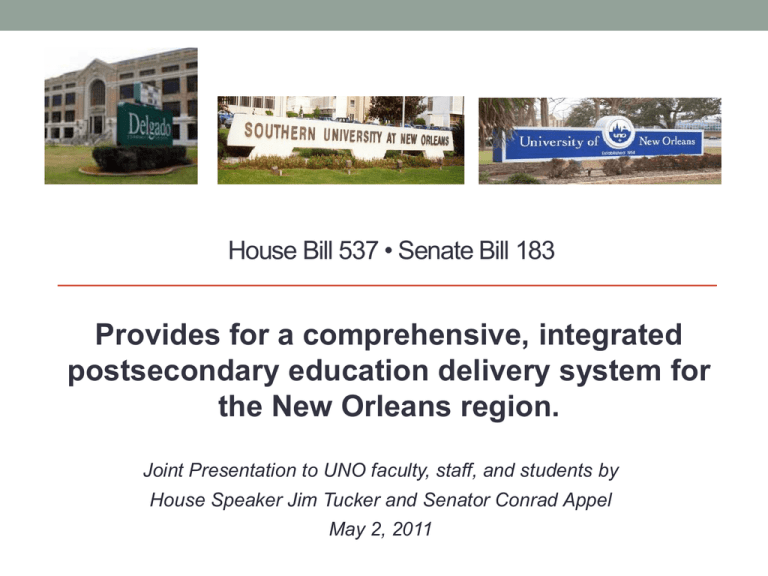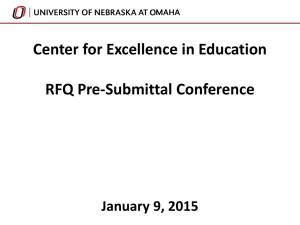Why the UL System?
advertisement

House Bill 537 • Senate Bill 183 Provides for a comprehensive, integrated postsecondary education delivery system for the New Orleans region. Joint Presentation to UNO faculty, staff, and students by House Speaker Jim Tucker and Senator Conrad Appel May 2, 2011 2 Why merge? Source: Senate Resolution No. 123 (2010 session) • Hurricane Katrina impacted postsecondary education in the region as severely as it did the cultural and physical landscape. • Colleges and universities have made diligent, valiant, and tireless efforts to rebuild and recover enrollment, facilities, and programs. Although great progress has been made, more progress is needed to produce student and institutional outcomes in accordance with the GRAD ACT. • Current levels of enrollment and funding and the quality and capacity of existing facilities are insufficient to sustain successfully the long-term viability of these postsecondary institutions. 3 Why the UL System? Founding Chancellor Homer Hitt knew in 1965 that UNO’s presence in LSU System did not serve UNO’s best interests. WDSU-TV July 21, 1965 4 Enrollment Why the UL System? FY 12 Executive FY09-10 FY10-11 Budget July 1 FY08-09 FY09-10 Mid Year Mid Year approved by Budget, Mid Year Decrease Cut Cut Regents vs. FY08-09 Cut (millions) (millions) (millions) LSU System (millions) (millions) proposal to HAC on 3/31/2011 Cumulative Reduction (millions) UNO 11,363 $70.9 $3.15 $6.0 $3.8 $1.6 $2.2 $16.7 LA Tech 10,607 $62.9 $4.5 $2.9 $0.6 n/a $10.7 $2.7 Comparing UNO’s recent budget reductions to those imposed at a like-sized institution in a budget unit with no “off-formula” entities demonstrates that UNO has borne $6 million more in budget cuts than similar institutions in the same time period. 5 Why the UL System? • More appropriate governance structure that groups UNO with other SREB-II institutions • Ability to be more responsive to needs of New Orleans industry and workforce: Ph.D. in Material Science – Time to approval:10 years. Ph.D. in Engineering and Applied Sciences (proposed in response to industry demand) – Time to approval: 5 years. 6 Why the UL System? • Ph.D. in International Studies – submitted 5 years ago; no review or comments received. Private donations received to date: approximately $1.85 million. • B.S. in Transportation and Center for Transportation Studies funded by state for three years prior to systemlevel approval. • Proposed change in format of online Engineering Management Program to meet demands of working students was denied. • Other attempts at similar e-learning proposals also denied. 7 Process June 11, 2010 Senate Resolution 123 introduced directing the Board of Regents to study public postsecondary education offerings in the New Orleans region January 18, 2011 Governor Jindal asks the Board of Regents to study merger, move to UL System, and greater collaboration with Delgado. March 14, 2011 The National Center for Higher Education Management Systems presents its findings. March 15, 2011 BOR votes to accept the report’s findings and recommends that the legislature adopt Alternative B. April 15, 2011 Deadline to file bills for the 2011 Regular Session of the Louisiana Legislature 8 HB 537 / SB 183 as proposed • Consolidation of UNO and SUNO into University of Louisiana at New Orleans (ULNO) • Within ULNO, two colleges with different admissions criteria, academic focus, and course offerings: 1) a research college with graduate programs and 2) a primarily undergraduate college • Branch campus of Delgado to be co-located on ULNO campus • Shared admissions and academic and financial aid counseling center (“portal”) located within Delgado at ULNO; serves both colleges and promotes transfer from 2-year institution 9 Revisions proposed by UNO • Refer to two colleges as “units” • Differentiation of diplomas from each unit • Differentiation of admissions: course level within each unit should be consistent with the mission of that unit. No single unit responsible for all general education courses. • Clarification of Delgado’s role: developmental instruction, lower level general education courses 10 Revisions proposed by UNO, cont. • Identify research-centered colleges to be located within the research unit, including sciences, social sciences, education, business, arts, and humanities. Degree programs offered by the research unit are critical to the regional economy. The research unit serves undergraduates who meet its admission requirements. • Consider name alternatives 11 Transition Timeline August 1, 2011 UNO and SUNO chancellors submit to SACS individual letters of intent to change governance to UL System management July 1, 2012 UNO and SUNO chancellors jointly submit to SACS statement of intent to consolidate under UL System management Immediately upon receipt of approval from SACS and final approval from the UL Board of Supervisors, SUNO and UNO cease to exist as separately accredited institutions and shall be consolidated, along with their assets, funds, obligations, liabilities, programs and functions into the newly and properly accredited institution. 12 End Result • World class educational environment that will meet the academic needs and interests of every student, while providing each student with the support, assistance, and guidance necessary to attain his/her goals. • Raise the educational attainment of the population, improve the quality of life, and contribute to the well being of the New Orleans region. • Optimal use of facilities, faculties, and other resources.



